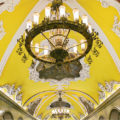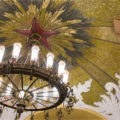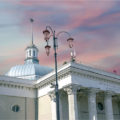The history of Komsomolskaya Station on the Koltsevaya line of the Moscow metro
One of the most extravagant stations of the Moscow metro was opened on January 30, 1952. The station was named for its location on Komsomolskaya Square, which is often called “Three Stations Square” because the terminals of the Leningradsky, Yaroslavsky, and Kazansky train stations are also located nearby.
The grandiose project of the architect Alexey Shchusev
Komsomolskaya station was built as a deep level station, located at a depth of 37 meters. Its platform became an experimental ground for trying the latest technologies in the construction of the Moscow metro. For example, the diameter of the central hall was the largest of all stations at that time — 11.5 meters. The escalator to the transition to the Komsomolskaya station on the radial line had the same diameter, which made it possible for the first time to fit four stairs at once.
The plan of the station was created by the famous Soviet architect Alexey Shchusev back in 1949. The architect was not destined to live to see the realization of his idea. His work was continued by his students — Viktor Kokorin and Alisa Zabolotnaya. Zabolotnaya later wrote that Shchusev planned the station to be one of the busiest transport junctions in the city and a gateway to Moscow.
The Komsomolskaya station is the apotheosis of the Stalinist Empire style, distinguished by its extraordinary solemnity. The station is designed in the style of Russian architecture from the 18th century. The guiding theme in its interior is the triumph of the Soviet people in the Great Patriotic War. The greatness of this patriotic theme is reflected in the grandiose scope of the hall and its splendid decoration. The vaults of the station are decorated with baroque stucco and huge mosaic panels of smalt and precious stones.
The magnificent mosaics of Pavel Korin
The Soviet artist Pavel Korin was entrusted to work on the mosaics. His contemporaries recalled: “[Korin] felt and understood architecture professionally”, he had to escape to monumentalism because his paintings were rarely exhibited, for which the president of the Academy of Arts and a former classmate of Korin was blamed.
Pavel Korin knew that Aleksey Shchusev wanted the Komsomolskaya station on the Koltsevaya line to be a continuation of the architectural theme of the Kazan railway station, on which Shchusev had previously worked.
While creating sketches of the mosaics, Pavel Korin visited Kazansky railway station repeatedly to examine the details of the Shchusev project.
The glorious mosaic panels created by Korin accurately illustrate the speech of Joseph Stalin that he gave at the parade on November 7, 1941: “The war that you are fighting is a war of liberation, a just war. Let the courageous images of our great ancestors — Alexander Nevsky, Dmitry Donskoy, Kuzma Minin, Dmitry Pozharsky, Alexander Suvorov, and Mikhail Kutuzov — inspire you in this war! Let the victorious flag of the great Lenin guide you! “
The mosaics created by Korin depict Kuzma Minin and Dmitry Pozharsky gathering the people’s militia on the Red Square; Prince Alexander Nevsky holding a flag with the image of Christ; Moscow prince Dmitry Donskoy, on a white horse, leading the troops to Kulikovo field; the great commander Alexander Suvorov crossing the Alps; Mikhail Kutuzov during the Battle of Borodino as well as Soviet soldiers and officers at the walls of the Reichstag.
There were three more mosaics, dedicated primarily to Stalin. In one of them he is depicted at the parade on November 7, 1941, standing on the mausoleum and holding a flag with the profile of Vladimir Lenin. A kneeling soldier kisses the flag. Behind Stalin there are members of the Politburo, the Kremlin towers, and ranks of soldiers going to the front lines.
The second mosaic depicts the capture of the Reichstag by the Soviet army in May 1945. In the foreground there are soldiers whose faces shine with happiness and behind their backs there are waving flags with the profiles of Lenin and Stalin. The destroyed Reichstag building became the background of the composition.
The third mosaic shows the Victory Parade held on June 24, 1945. On the podium of the mausoleum Stalin is surrounded by members of the Politburo and the highest ranking army officials. A guard of honor watches the doors of the mausoleum. Soldiers throw the flags of defeated Nazi Germany to the base of the mausoleum.
Alterations to reflect the changing times
These three panels, glorifying the personality of the leader of the peoples, did not last long. In 1961, after the denouncing of Stalin’s cult of personality at the 22nd Congress of the Communist Party, it became clear that the mosaics had to be redone. Before the panels had been slightly modified to remove certain members of the Politburo who had fallen into Stalin’s disgrace.
The reconstruction of the mosaics was not easy. The panel depicting Stalin’s speech at the 1941 parade had to be re-created almost from scratch: the leader of the peoples was substituted with Vladimir Lenin and Soviet fighters — with soldiers from the Civil War.
The members of the Politburo, standing on the mausoleum, were also removed from the panel devoted to the Victory Parade. They were replaced with the allegorical figure of the Motherland, standing on the flags and holding a hammer, sickle, and an olive branch as the symbol of peace.
The only panel that underwent only minimal alteration was the one with the capture of the Reichstag: the profile of Stalin was simply removed from the mosaic.
It took several years to redo all the panels. The work was carried out only at night not to disturb the passengers using the station.
The Soviet masters performed incredible work both during the construction and the alteration of the mosaics. The area of each panel is 30 square meters, the weight is three tons, and the number of typesetting elements is 300 thousand pieces. All of them not only made a great impact on the audience but also dazzled with the technique and quality of their workmanship. The sketches, made in full size, were used by teams of craftsmen to lay out pieces of colored stones and smalt. Then these fragments were positioned on a cement-coated substrate. The finished mosaic was installed on the vault of the station at a height of nine meters.
Following the tradition of mosaic laying, the backgrounds of the panels were decorated with gold leave. Pavel Korin, familiar with the traditions of Russian and Byzantine art, applied this technique, originally used only for icons, in his work.
This is how Korin himself evaluated his work: “I consider the images of Nevsky, Donskoy, Minin and Pozharsky, Suvorov and Stalin to be successful mosaics. The mosaic with Kutuzov is slightly marred by haste, the Victory Parade is poorly executed, and the Taking of the Reichstag is spoilt by the careless workers from the mosaic workshop of the Leningrad Academy.” Later, having received the Stalin Prize for the design of Komsomolskaya, the artist said: “Even with their shortcomings, the mosaics live, and they live a solemn life, they have excitement and creativity.”
Beauty and greatness in everything
The grandiose impression of the station was created not only through the stucco molding and mosaic panels. The architects decorated the station with bas-reliefs depicting the production of Russian weapons from ancient times to 1952 when the station was opened. There are guns, machine guns, swords, helmets, among others. In 1965, for unknown reasons the bas-reliefs were replaced with emblems created from the sketches of Pavel Korin.
Just like the walls, the columns of the station are finished with light marble, and the floor is made from red granite. The platform ceilings are decorated with massive chandeliers in the form of rings, on which is placed a multitude of fixtures with lamps.
The far end of the station seems “forgotten” amidst this splendor. To brighten up the emptiness, a high pedestal with a bust of Lenin was placed here against the wall. The wall itself was decorated with a mosaic with the coat of arms of the Soviet Union in its center and a floral ornament along the edge.
In 1958, at the World Exhibition in Brussels the layout of the Komsomolskaya station on the Koltsevaya line received the Grand Prize. In addition to the high assessment of the architectural component of the project, the jury noted its visual elements, created by Pavel Korin’s mosaics.
Kira Lenskaya



